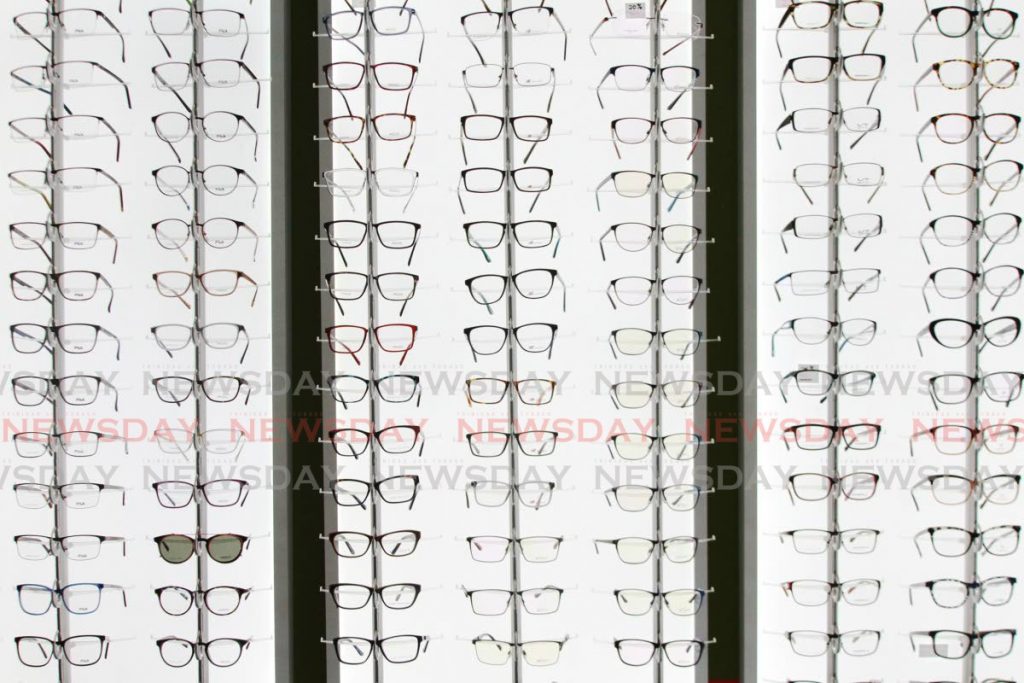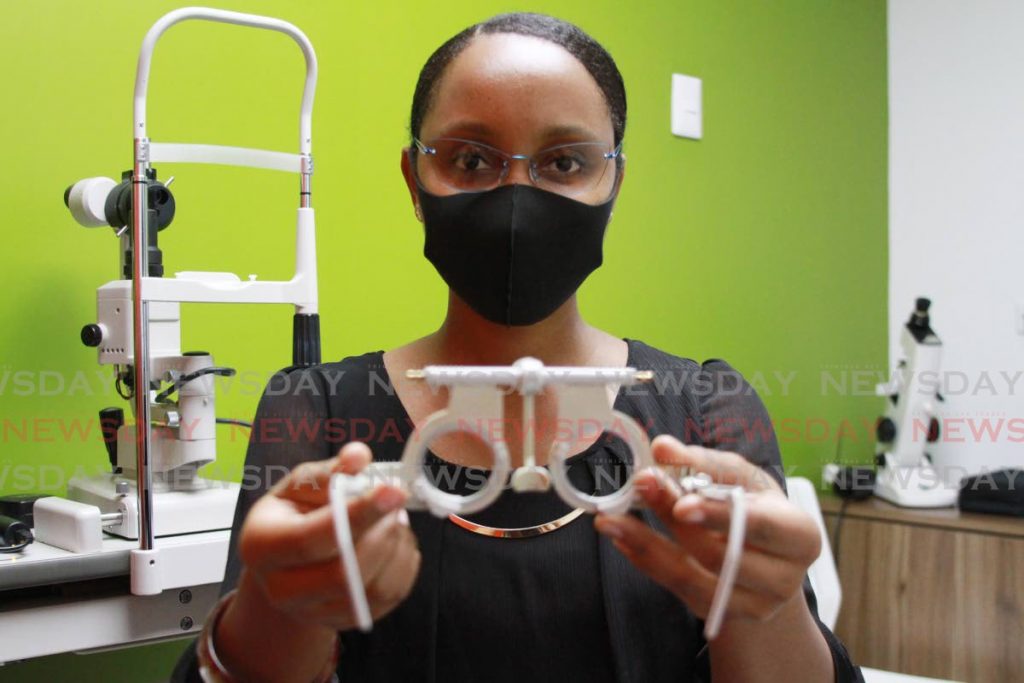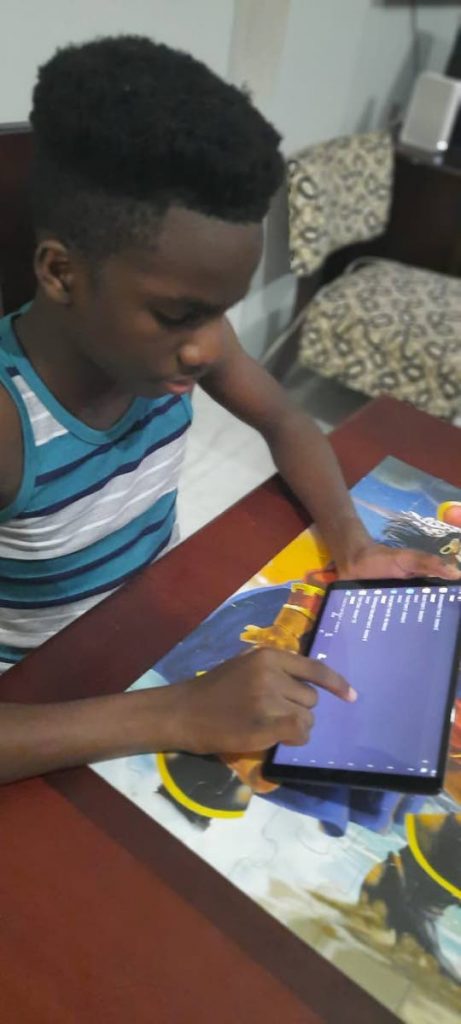Online classes causing eye problems in children

At a time when technology is advancing rapidly and spending more time behind a screen has become the norm, it poses a significant threat to eye health. More children are having their eyes tested and buying glasses since the switch to online learning.
In August 2020, the Prime Minister announced the closure of schools to prevent the spread of the covid19 virus. And while some teachers had already been using online learning platforms, after this, things went fully digital. This led to a surge in purchases of laptops, tablets and other digital devices.
Damir Ali teaches maths to form one, two, four and five students, and said many complain about their eyes feeling tired.
“Just watching a screen all day strains your eyes, especially with the brightness, and then you’re inside all day.
“For a lot of people – including me, because I spend a lot of time indoors with a bright screen – it started becoming a problem with focusing, because I’m there all day, and the same thing applies to the students.”
His students have around four classes a day, with 30-minute breaks.
Computer Vision Syndrome (CVS) refers to problems with eye and vision-related issues resulting from prolonged use of digital devices. Symptoms include dry or red eyes, headaches and blurred vision.
Ali said he got advice from an optometrist and started implementing certain practices to reduce the strain on the students, for example, the 20-20-20 rule. Every 20 minutes, you look at something approximately 20 feet away for 20 seconds. This allows the eyes to refocus.

President of the Opticians Association of TT (OATT) Soomarie Singh said a major issue is that many children not only work on digital devices, but play there too.
She runs Sight Solutions Optical Centre Ltd in Chaguanas. Statistics from her business show that in 2019, 84 children visited for eye exams and 36 needed glasses. But in 2020, 137 children visited and 60 needed glasses. There was also an increase in children with dry eyes in 2020.
“Remember, kids still engage in things like games, some of them like to watch YouTube videos, listen to music or watch tutorials. So even in their relaxing time, during their break, instead of taking a break from the devices, they just continue – music rather than go out to play.
“A lot of times it turns out (the problem) is eye strain from being on the device for too long.
“There has not only been an increase in kids getting their eyes tested but an increase in kids needing prescriptions. And not just small (minor) prescriptions, high ones.”
Another possibility could be that the child had needed glasses long before the pandemic, but because they have been using electronic devices more, the eye strain caused them to come and get tested.
“Change in prescription is something that happens naturally. The body changes, the eye changes as well...What you may find is a child has -2 prescription and next year they have a -3...”

Keron Ramsey is the father of three boys – ten, seven and five. The younger two mainly use the physical worksheet packages provided by their schools, but the eldest, Azarel, spends the most time behind a screen for learning.
“He is in standard four and he has to spend around four or five hours on Zoom every day (for class). The first session runs from 9 am and it could run for an hour and a half or two hours sometimes. Then they get assignments to do so, it’s not a break per se.”
After class, Azarel still has to spend time behind a screen doing homework.
“He’s getting headaches more frequently.” They’re so bad that he has to lie down.
“He’s also been complaining about his back. I’ve had to give him a massage a few times in the last couple of weeks.”
Even after homework, he enjoys playing video games. Asked how long the children spend playing on these devices, Ramsey said, “Every free moment that they have.”
Before the pandemic, his sons would play outside at a nearby playpark. But this has since been limited.
“Every other day, I would take them out. They run, they have bikes, skateboards...They still go outside, but not as often, because I’m really trying not to have them interacting with everybody. We live in a housing development complex, so there are a lot of people using the park.”
Stacy St Louis told Newsday her ten-year-old son Seth has also been complaining of eye strain recently. His online sessions begin at 9 am and end at 2.30 pm and he uses a desktop computer. He gets an hour for lunch and two ten-minute breaks. But he only truly finishes with schoolwork around 4 pm after completing his homework.
“Teachers are hardly using (physical) textbooks now. Everything is on the screen. So, in addition to playtime like gaming after classes, it’s pretty much all day (that he’s on the computer). Recently, he said, ‘Mummy, you know I’m not seeing as good as I used to see before?’ He gets headaches occasionally too.”
Optometrist at Look Opticians Antoinette Williams told Newsday she has been hearing this complaint often, in addition to dry eyes and headaches. And while there are many types of eye drops one can buy at a pharmacy, she suggested people get their eyes checked first. Some eye drops can have a negative effect on people with high blood pressure.

Managing director of Ideal Vision Optical Brent Khan also told Newsday more children are needing eye exams and glasses.
“Using these devices so close up, they tend to become shortsighted at an earlier age or get dry eyes, which results in itchy, watery, burning glare-sensitive eyes...
“We want to alert the authorities that yes, we know things are a bit more virtual now, but there has to be requisite advice and you need to think about how you do it.”
St Louis said she tries to encourage her children to go outside to play more often. Both she and Ramsey said they will be taking their children to get their eyes tested.
St Louis said, “I am a glasses-wearer. I’ve been wearing glasses since I was in standard one, so prior to covid19, knowing how early I started wearing glasses, I took him (and my two daughters) for (eye) checkups. And they were all fine. It’s only now Seth is complaining about not seeing as well as before.”
President of the TT Optometrists Association (TTOA) Lauren Robinson, who works at Ferreira Optical Ltd, said it has been a very long time since she has seen so many children come in to check their eyes. She has been in the field for over 26 years.
Their main complaints are burning, tired eyes and headaches. “They even complain about neck aches and backaches as well because they’re usually hunched over on a tablet, laptop or on a phone...
“Now, as an adult, you just think about staring at your little phone screen and looking at that whole day, hearing the teachers talking and having to write notes from this little screen. Because not everyone can afford laptops and tablets. Some of them could only afford a phone or have to use their parents’ phones. And the bigger the screen, the easier it is to manoeuvre and see.”

She too recommended the 20-20-20 rule.
“It’s the same as if you were to walk from Tacarigua to Port of Spain without stopping. You will reach, but you’ll be really tired. But if you take breaks along the way, it would be better.
“But some children have classes that go for up to two hours without a break. And even if there is a five-minute break, that’s just enough to log out of one class and log in to another.”
She is urging parents to let children explore other options during their break time instead of playing on devices.
Myopia is shortsightedness, or the inability to clearly see objects that are far away. Since the onset of the pandemic, it has increased globally. Robinson said it is being called quarantine myopia.
“You can become more short-sighted just by staring at the screen for lengthy periods. There are children who were short-sighted even before the pandemic, but it increased because of the extensive screen time. I tested a little boy pre-covid19 and he was fine, but I’m testing him now and it’s like, okay you’re a little short-sighted.”
Before the pandemic, she would suggest a maximum of three hours for children to be allowed behind a screen. But now?
“There is a limit – but you can’t put a limit now. Their schoolwork is important.”
What can help?
20-20-20 rule
Ensure children get time away from these screens during their break time
Lower brightness and contrast on devices
Use them in well-lit rooms
If their eyes are fine at their first check-up, take them back six months later to see if anything has changed
Annual eye tests are generally suggested


Comments
"Online classes causing eye problems in children"